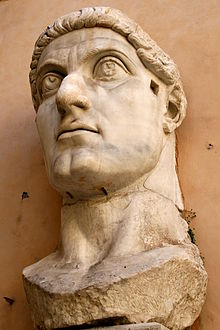Colossal statue of Constantine the Great
The colossal statue of Constantine the Great was a twelve meter high marble statue of Emperor Constantine in Rome.
Constantine had it made after his victory against his rival Maxentius in the battle of the Milvian Bridge around 312-315. As a demonstration of the newly won power, the statue was erected in the Maxentius basilica on the edge of the Roman Forum (on the Via Sacra ), which is therefore also known as the Basilica of Constantine. The statue stood in an apse of the basilica, where it depicted Constantine as the rapt and deified emperor. The acrolite statue made of white marble originally showed the emperor sitting, his right foot slightly in front and holding a scepter in his left hand. He wore a paludamentum (probably made of bronze, possibly also made of wood) that covered most of his legs and his left shoulder. However, only a few fragments of the original have survived today: both feet, one hand, the head and parts of the legs, arms and chest. They are exhibited in the courtyard (Palazzo dei Conservatori) of the Capitoline Museums in Rome . The preserved parts were discovered as early as the 15th century.
In 2018, a finger (previously interpreted as a toe) was identified in the Louvre in Paris as probably belonging to the colossal statue.
Reconstructions
The Berlin architect and artist Yadegar Asisi made a 3D reconstruction of the statue in 2005 for his Rome CCCXII project . It was exhibited in the Panometer Leipzig , among others .
For the Constantine Exhibition in Trier in 2007, the world's first copy of the approximately three meter high marble head was made. Following a workflow developed by the sculptor Kai Dräger, Prometheus Projekt GmbH and the Fraunhofer Institute IPK , the museum copy was made from a 20-ton block of Carrara marble from high-resolution 3D scan data in several process steps . The copy of the monumental foot is also based on 3D scan data and was milled from Styrofoam and then poured out of concrete in triplicate.
literature
- Johannes G. Deckers : The Colossus of Constantine. In: Luca Giuliani (ed.): Masterpieces of ancient art. CH Beck, Munich 2005, ISBN 3-406-53094-X , pp. 158-177.
- Eckart Köhne: Colossal head of Constantine the Great (copy). In: Alexander Demandt , Josef Engemann (ed.): Konstantin der Große. Emperor Caesar Flavius Constantinus. Philipp von Zabern, Mainz 2007, ISBN 978-3-8053-3688-8 , CD-Rom (I.8.1).
- Claudio Parisi Presicce: Constantine as Iuppiter. The colossal statue of the emperor from the basilica on Via Sacra. In: Alexander Demandt, Josef Engemann (ed.): Konstantin der Große. Emperor Caesar Flavius Constantinus. Philipp von Zabern, Mainz 2007, ISBN 978-3-8053-3688-8 , pp. 117-131.
Web links
Remarks
- ↑ Klaus-Martin Girardet expressed doubts about this dating in 2010 (The Emperor and his God. Christianity in Thought and in the Religious Policy of Constantine the Great. De Gruyter, Berlin-New York 2010, pp. 91–92), also recently the ancient historian Florian Haymann, Antike Welt 4 2020, pp. 82–84. According to both, the colossus is likely to come from the time after the victory against Licinius, around 325 AD.
- ↑ World June 1, 2018: Emperor Konstantins Zeh is actually his finger , accessed on June 2, 2018
- ↑ 1: 1 copy of the head


